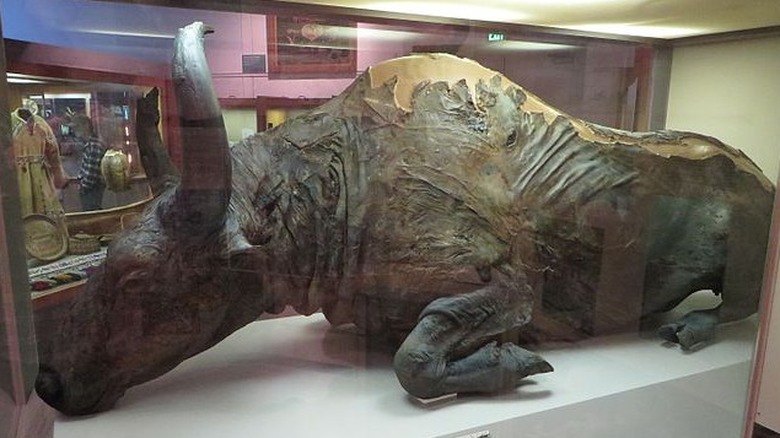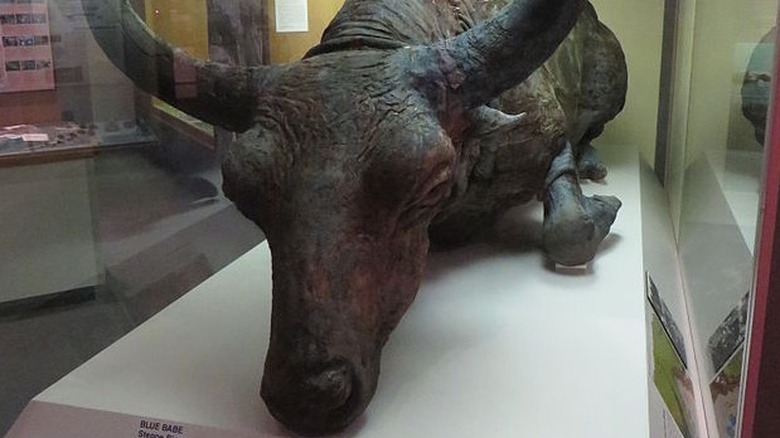Why Paleontologists Decided To Eat Their 50,000-Year-Old Animal Discovery
In 1979, gold miners near Fairbanks, Alaska uncovered the find of a lifetime. Buried in the frozen tundra wasn't gold at all, but instead, a frozen and amazingly well-preserved animal from the last ice age. After excavation, the creature was studied at the University of Alaska, and at first, it was thought to be some 36,000 years old, according to the University of Alaska website. More recent estimates, though, say the animal lived at least 55,000 years ago, based on NPR reporting.
Such finds of frozen animals from the last ice age are rare but not unheard of, and whenever they're found, they provide an unparalleled glimpse back in history, as Smithsonian Magazine explains. In the case of the frozen ancient animal uncovered in Alaska, some wondered — what might the animal taste like, after thousands of years in a deep freeze? In 1984, one University of Alaska Fairbanks paleontologist, Dale Guthrie, decided he'd like to find out, and he invited some friends over to try to taste it with him, according to Atlas Obscura.
The frozen ice age animal was named 'Blue Babe'
The animal that gold miners uncovered in 1979 and that is now on permanent display at the University of Alaska Museum of the North is an ice age steppe bison (pictured), and evidence suggests it was killed by the now-extinct Ice Age American lion, Panthera leoatrox. After it was excavated, a chalk-like blue substance was found on the animal — a byproduct of phosphorus from the animal tissue as it met iron in the soil — and for this reason, the creature was nicknamed "Blue Babe," as the University of Alaska website goes on to note.
The notion of tasting the meat — which likely froze quickly after the bison died — was not unique to the Alaskan researchers, according to a 2019 report from The Atlantic. Paleontologist Dale Guthrie told Atlas Obscura his team had heard about Russian scientists excavating bison and mammoth. Those finds were frozen enough to eat at the time of their discovery, just like Blue Babe, with textured muscle tissue, and preserved fat and bone marrow. "So we decided, 'You know what we can do? Make a meal using this bison,'" Guthrie said.
Guthrie made stew from a small portion of the bison's neck
The meal that Guthrie decided to make was a stew from a small bit of meat cut from Blue Babe's neck. The meat, which had freeze-dried while still fresh, smelled faintly like beef once it had finally thawed out. According to Guthrie, it also had an earthy aroma mixed with the scent of mushrooms. The meat was then cooked with vegetables and spices with garlic, onion, and potatoes in a stew. About a dozen people attended the dinner party, as Guthrie wrote in his 2013 book "Food History Almanac."
All told, the ancient meat stew tasted "okay" and nobody at the dinner party that night got sick from the Ice Age meal. As Guthrie said (via Atlas Obscura), "It tasted a little bit like what I would have expected, with a little bit of wring of mud ... But it wasn't that bad. Not so bad that we couldn't each have a bowl." In 2021, Guthrie's wife, Mary Guthrie who tasted the stew that night, appeared on the "Every Little Thing Podcast" and recalled her experience eating at least 50,000-year-old beef stew. "It was a good stew, and then we put the bison in," she said.


